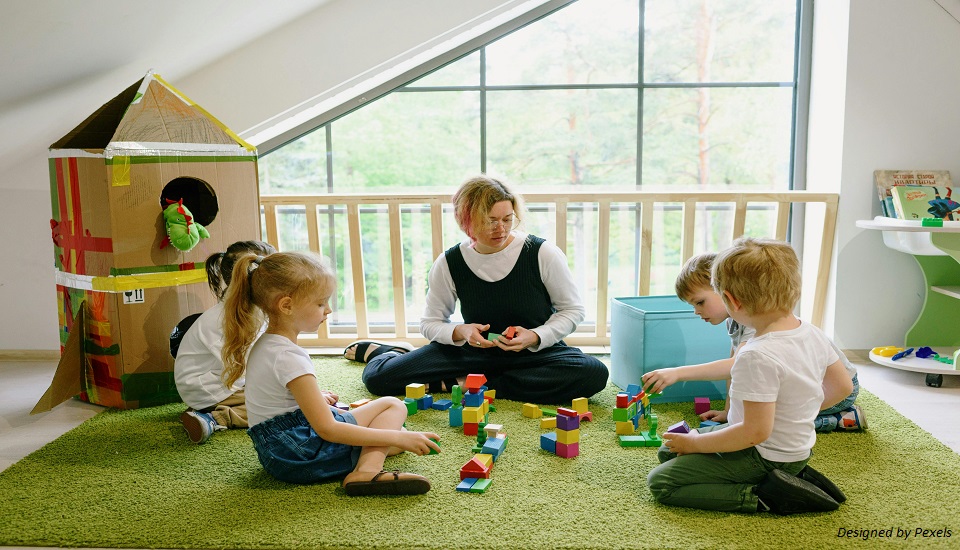4 MAGIC Ways Learnt To Train with Pre and Primary Teacher Training Course
23rd October 2018

It is always a difficult task to teach and train the little ones. They are young, dynamic and energetic to ask questions and storm the classrooms.
Playful enactment of learning is the only best yet possible option identified by the new-age teacher training techniques. Such that modern day pre and primary teacher training course train the aspiring and experienced teachers to use the 4 magical ways. Or the 4 Magical spell that can be casted upon the young minds who love to dream!
Let’s unfold these four ways which are part of the teaching techniques -
1. Feely Bag –
The main purpose of this feely bag is to encourage conversation and increase the vocabulary.
But what it is?
The material is a bag or either cloth or cane or plastic which ever you can provide to the learners. Make sure they cannot see through it.
How to arrange?
All you need to do is keep around 6 to 8 items on a theme based manner. You can use images or pictures that can be used if you don’t find the presence of any actual or real object. However, it is suggested that it should be one or the other but not both.
How the child reacts!
The child puts his hand into the bag and picks out an item. Without looking at it the child tries to guess what is inside the bag and then take out the items one at a time. The best thing is that the items should be in a proper theme based manner, depending on what the children are currently interested in. Then again you being the global educator or teacher could teach and train the young learners a short rhyme or song that is related to the objects.
Some of the hot suggestion for the themes or topic could be as follows:
- Things that keep me clean
- Vegetables and Fruits
- Things I find in the Garden
- Green
2. Sorting Tray –
The main purpose of this sorting tray is that it can be used for many different activities which can be related to classifying and sorting, whether it is in connection with number or language.
What does it have?
The material includes any box that can be divided into about six sections. There should be enough such trays for about 6 to 8 children to use at a time (one group). Tin biscuit boxes are useful as are plastic masala containers. But any firm cardboard box can be used when carefully divided by firm strips of cardboard.
Counters must be provided in abundance and these should be of a suitable size to fit into the sections of the sorting tray. If pictures are to be sorted then they must be of the right size and are best when mounted on cardboard.
How effective is it?
Wooden boxes last a long time but are expensive to make. Wooden trays are very durable – but expensive. Strong cardboard can be affixed by the teacher. Plastic spice trays can be a useful substitute.
3. Flannel Board –
The vital objective of this flannel board provides an excellent display surface. The visuals used on it are flannel-backed and adhere to the board – almost like magic!
What materials are required?
A base of either stiff cardboard or Masonite, or any firm material available to the teacher. The size is particularly determined by the teacher’s ability to hold the board comfortably while talking to the class. A bigger board can be placed on an easel. Sufficient flannel in a neutral shade but not white to cover the board, making sure that the material is smooth with no wrinkles.
How it impacts?
As such any visual can be displayed, provided it is backed with flannel. Sand paper is a cheaper substitute, but needs to be tried beforehand, as the size of the visual sometimes proves the sandpaper backing too heavy and the visual will not adhere to the board. A plastic cover for the board ensures that the flannel board remains clean for longer. This plastic cover for the board looks more or less like a cushion cover.
In the end one must understand that the scraps of flannel are useful for the visuals and make the child connect to learn colours. Use of colour plays an important part such that a dark background is good for highlighting vivid primary colours. Obviously the pre and primary teacher training course accepts and highlight this fact when explaining the need of vibrant colour which attracts the cognitive scape of a children.
4. Snap cards –
The vital purpose of these snap cards is such that it aid children to orient their numerical and linguistic development. These are a form of practising visual discrimination and that is possible only because the concept is presented in a ‘game-based form’ which must be popular.
What are the needed materials?
Cardboard sets which must be either the size of a card or slightly smaller like a playing card. The cards are prepared in pairs with a number, pattern or picture duplicated on each pair. As a responsible teacher you need to arrange the post card sized pairs, which also must include pictures, letters, numeral or even words.
The most important and basic requirement is each set must have a theme and should consists of 8 to 10 pairs. The cards are well-shuffled and divided between players.
Written By: Rimpa Ghosh